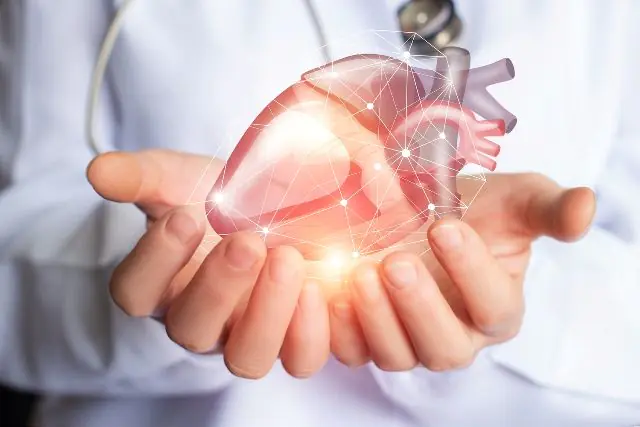
What is pericarditis, why does the disease occur? Signs and diagnosis of pathology. How to treat pericarditis: medications, surgery. Disease prevention.
The content of the article:- What is pericarditis
- Reasons for development
- Main symptoms
- How to treat pericarditis
- Medicines
- Surgical intervention
- Prevention
Pericarditis is one of the most frequently diagnosed pathologies of the pericardium (the outer lining of the heart). Disturbances are caused in most cases by inflammatory processes and are evidence of progressive pathologies of the cardiovascular system. With timely treatment of pericarditis, the prognosis is very favorable. However, the possibility of relapses cannot be ruled out in the future, so patients or those prone to pathology should follow the doctor’s recommendations.
What is pericarditis?
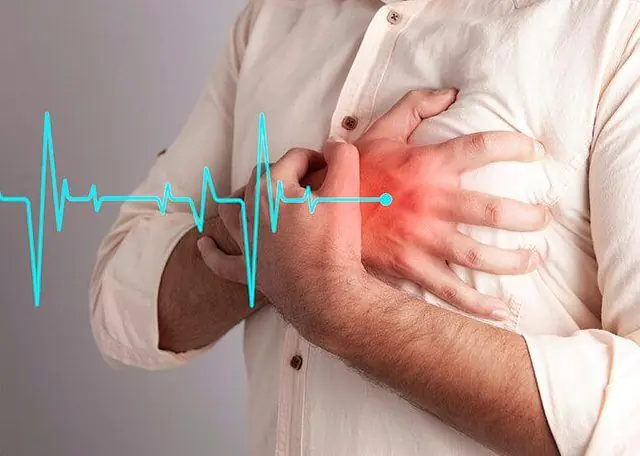
The pericardium, also called the cardiac sac, is the outer lining of the heart. In a healthy person, there is normally serous fluid between the pericardium and epicardium (middle layer). Its composition is close to blood plasma, and the main task is to reduce friction between the membranes, thereby relieving the load on the tissue.
Inflammation of the outer lining is called pericarditis. Symptoms of the disease often appear against the background of progressive pathologies of the cardiovascular system, less often as an independent disorder. The development of the inflammatory process leads to the accumulation of serous fluid, and as a result, disruption of the heart. If in a healthy person the volume of the pericardial cavity is up to 30 ml, then after pericarditis is diagnosed, the amount of fluid increases. In turn, the heart begins to experience additional stress from the outside. Being compressed from the outside, muscle fibers cannot perform their functions normally.
The situation is complicated by the fact that until a certain time the patient’s compensatory mechanisms of the body are triggered. That is, the first signs of pericarditis, causing discomfort to the patient, can appear only at the stage of development of heart failure. No less dangerous are acute pathological conditions, when fluid accumulates quickly and symptoms appear instantly. In this case, a large amount of serous composition does not allow the myocardium to straighten after contraction. The heart loses its ability to pump blood, and accordingly the entire body experiences a lack of blood supply.
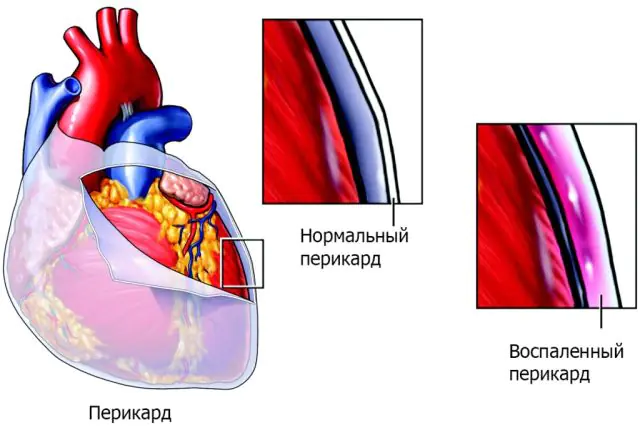
Normal and pericarditis
If the disease developed gradually and transformed into a chronic condition, then over time the inflammatory processes subside, the amount of fluid in the interthecal cavity normalizes, and the second phase of pericarditis development begins. This stage is also called “dry”. The amount of fluid in the pericardium ranges from 5 to 30 ml, but its qualitative composition changes significantly. It contains protein compounds that eventually merge and grow together, forming fibrin adhesions. Such adhesions also disrupt the normal functioning of the heart, preventing it from contracting.
Epidemiological figures for the disease continue to be clarified. Data collection is complicated by the fact that symptoms of pericarditis do not always appear during life. Thus, in the USA, the disease is detected in 1 case out of 1000. Meanwhile, 3% of autopsies show that a person had pericardial pathology, while 80% of patients did not even see a doctor during their lifetime. At the same time, the disease can be detected during a full clinical examination. Practice shows that 0.5% of people who turn to therapists actually also require consultation with a cardiologist on issues of inflammatory processes of the pericardium.
Causes of pericarditis development
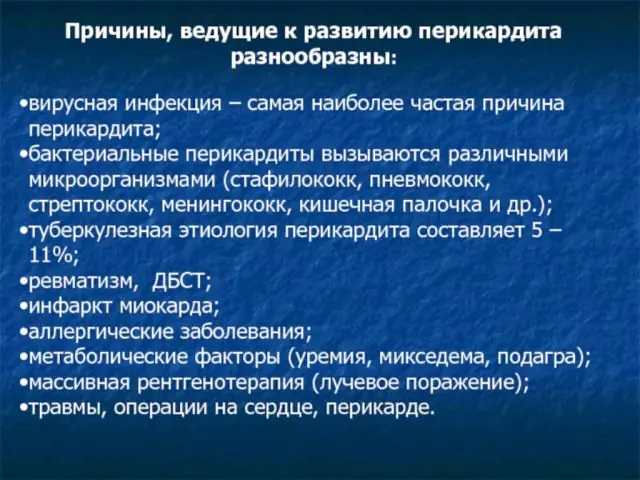
Primary pericarditis, that is, provoked by congenital anomalies of the heart, is extremely rare. The secondary form of pathology is caused by a number of diseases. However, a clear relationship between the etiology of pericarditis and its external manifestations has not yet been established. If, however, it was possible to establish the primary disease and eliminate its harmful effects on the cardiovascular system, the effectiveness of such treatment increases significantly.
According to the etiology of pericarditis, the following types of disease are distinguished:
- Infectious. An illness caused by infectious diseases. Viral infections are a common cause of pathologies (up to 10% of all acute cases), but it is also possible to develop dysfunctions under the influence of bacterial (8% of all cases), fungal and parasitic infections (a rare form).
- Non-infectious. The disease is provoked by renal failure, cancer, heart attacks or rare forms of autoimmune disorders. This type of pericarditis also includes acute conditions caused by physical trauma or planned cardiac surgery.
- Idiopathic. The cause of the pathology has not been definitively determined. According to various sources, the number of patients fluctuates around 25-85%, while doctors do not rule out a viral etiology of the disease, but do not have a sufficient diagnostic base to confirm assumptions (this situation is typical for developing countries).
Main symptoms of pericarditis

Chest pain due to pericarditis
The clinical picture depends on the type of pericarditis and the speed of its development. The acute form is characterized by sudden pain in the chest area. Unpleasant sensations intensify when swallowing and even just breathing. The patient develops shortness of breath and a nonproductive cough, and in some cases general weakness and fever. If you listen to the patient in this state, you can hear a characteristic noise, reminiscent of skin friction, in the chest area.
As fluid accumulates, the pain transforms and becomes compressive in nature. The patient experiences a feeling of palpitations and frequent dizziness, and the friction noise disappears when listening (due to the large amount of fluid). Signs of pericarditis after a heart attack are supplemented by joint pain and high fever.
An excessive amount of serous composition provokes compression of the heart muscle, a decrease in the amount of blood pumped in one contraction, which in turn causes cardiogenic shock and even death of the patient. Symptoms of impending shock include swollen veins, low blood pressure, and cold but clammy extremities. In addition to cardiogenic shock, other complications of pericarditis may develop - congestion in the systemic circulation, myocardial inflammation, and cirrhosis of the liver. Pathologies are destructive both individually and in combination.
Important! Symptoms of the disease in acute form may be periodic. 25% of patients note a gradual decrease in symptoms and their subsequent appearance after a month or even a year.
Suspicions about inflammation of the heart sac may arise already at the first pain in the chest area, especially during moments of active breathing. The doctor should tell in detail about the nature of the discomfort, their frequency and associated factors (is there shortness of breath, swelling of the extremities.) The patient must be listened to, blood pressure and pulse are measured. Data from a physical examination may be sufficient to suspect inflammation of the outer lining of the heart, but to confirm the diagnosis, a series of laboratory and instrumental tests will be required.
Laboratory diagnosis of pericarditis involves assessing a general blood test and biochemistry. Additionally, tests are taken to evaluate rheumatoid factor, antibodies to DNA and other specialized tests. As a rule, patients have increased ESR and leukocytosis, high levels of C-reactive protein. Additionally, ECG, CT, and MRI of the heart are prescribed.
Important! Diagnosis of pathology is necessarily accompanied by the identification of the provoking disease and the search for a method of treating it.How to treat pericarditis?
In this case, therapy is aimed at relieving the pathogenic condition in order to prevent complications of pericarditis. If the disease cannot be stopped, doctors’ attention is directed to alleviating the patient’s condition and reducing the symptoms of the disease. How to treat pericarditis largely depends on the etiology of the causes of the disease, as well as its form. In the early stages of pathology development, only pharmacological agents and complete blockade of the leading disease can be effective; in later stages, cardiac surgery will also be required.
Medicines for the treatment of pericarditis
Colchicum dispert for the treatment of pericarditis
Only the attending physician determines how to treat pericarditis in a patient. The dosage and combination of drugs is selected strictly individually.
For therapy with pharmacological methods, the following groups of drugs are prescribed:
- Nonsteroidal anti-inflammatory drugs. This category of drugs includes Indomethacin and its analogs Metindol, Ketorol, Nurofen. Studies show symptom relief after the second dose. Depending on the drug used, the course of treatment can last from 5 days to 4 weeks. One package of Indomethacin costs 38 hryvnia, 65 rubles, but several packages may be needed to complete the course. Analogues of the drug are more expensive.
- Glucocorticosteroids. Prednisolone, Kenalog or their analogues are indicated for severe pain syndrome. Prednisolone costs 38 hryvnia, 36 rubles.
- Tropolone alkaloid colchicine. Used in the treatment of chronic conditions. Most often, patients are prescribed Colchicum-dispert 1-2 tablets per day for 3 months in a row. The drug costs 675 hryvnia, 963 rubles.
Additionally, for pericarditis, medications may be recommended to normalize cardiac activity. Thus, medications based on furosemide reduce the state of venous stagnation, and dobutamine stimulates myocardial function.
Surgery for pericarditis
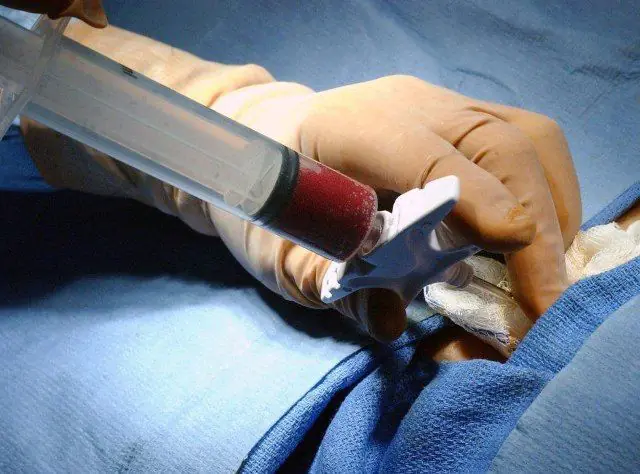
Complicated forms of pericarditis will require specific treatment. Therapy includes both pharmacological agents and surgical operations.
The following are actively practiced in cardiac surgery:
- pericardectomy - excision of the pericardium;
- pericardiocentesis - removal of fluid from the cavity;
- application of an artificial pericardial window - removal of a small section of the pericardium.
Treatment of the purulent form of the pathology will also require open drainage of the pericardial cavity, and therapy of the tuberculosis form is supplemented by taking anti-tuberculosis drugs. To reduce pain, such patients may be prescribed non-steroidal anti-inflammatory drugs. If taking this group of drugs does not produce results, corticosteroids may be prescribed.
Important! It has been noted that the use of corticosteroids increases the risk of disease relapse. Therefore, drugs in this group are not recommended for use during the first episode of the disease or for drug prevention of pericarditis.Prevention of pericarditis
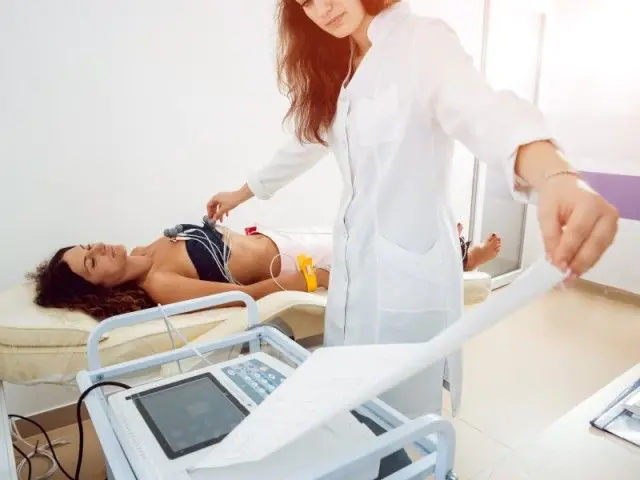
The methodology for specialized prevention of pericarditis has not been developed to date, since the disease is predominantly secondary in nature. The main recommendation of doctors in this case is timely and competent treatment of provoking pathologies, as well as general improvement of health. It is recommended to normalize your diet, supplement your day with daily physical activity, and avoid stress and overexertion.
With age, you should pay more attention to preventive examinations, and when the first pain in the chest appears, especially when breathing, you should urgently consult a doctor. If pathologies of any etiology are detected, their sequential therapy is necessary.
How to treat pericarditis - watch the video:
Pericarditis is a dangerous disease, the symptoms of which are often hidden or ignored by older patients. Meanwhile, severe forms of pathology end in death. Of course, prognoses depend on the etiology of the disease, but if the development of pericarditis is detected in the early stages, then the harmful consequences can be avoided. Competent treatment with medications, and, if necessary, with pericardiectomy, gives positive results in 71% of cases. That is why it is important to undergo preventive examinations and properly treat any diseases that can cause such serious complications in the heart.



